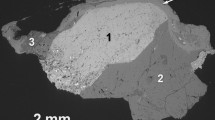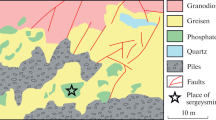Abstract
This paper presents a description of a new zirconosilicate of the eudialyte group, which was named davinciite in honor of Leonardo da Vinci (1452–1519), a famous Italian scientist, painter, sculptor and architect. The new mineral has been found in hyperagpaitic pegmatite at the Rasvumchorr Mountain, Khibiny Pluton, Kola Peninsula, as relict inclusions, up to 1–2 mm in size in a rastsvetaevite matrix. It is associated with nepheline, sodalite, potassium feldspar, delhayelite, aegirine, shcherbakovite, villiaumite, nitrite, nacaphite, rasvumite, and djerfisherite. Davinciite is dark lavender and transparent, with a vitreous luster and white streak. The new mineral is brittle, with conchoidal fracture; the Mohs’ hardness is 5. No indications of cleavage or parting were observed. The measured density is 2.82(2) g/cm3 (volumetric method); the calculated density is 2.848 g/cm3. Davinciite is optically uniaxial, positive; ω = 1.603(2), ɛ = 1.605(2). It is nonpleochroic and nonfluorescent in UV light. The new mineral slowly breaks down and gelates in 50% HCl and HNO3. It is trigonal, space group R3m. The unit-cell dimensions are a = 14.2956(2), c = 30.0228(5) Å, V=5313.6(2) Å3. The strongest reflections in the X-ray powder diffraction pattern [d, Å (I, %) (hkl)] are as follows: 2.981(100)(315), 2.860(96)(404), 4.309(66)(205), 3.207(63)(208), 6.415(54)(104), 3.162(43)(217). The chemical composition (electron microprobe, H2O calculated from X-ray diffraction data) is as follows, wt %: 12.69 Na2O, 3.53 K2O, 11.02 CaO, 0.98 SrO, 0.15 BaO, 5.33 FeO, 0.37 MnO, 0.07 Al2O3, 51.20 SiO2, 0.39 TiO2, 11.33 ZrO2, 0.21HfO2, 0.09 Nb2O5, 1.89 Cl, 0.93H2O, -O = Cl2 0.43; total is 99.75. The empirical formula calculated on the basis of Si + Al + Zr + Hf + Ti + Nb = 29 (Z = 3) is (Na1l.75Sr0.29Ba0.03)Σ12.07(K2.28Na0.72)Σ3Ca5.99(Fe2.26Mn0.16)Σ2.42(Zr2.80Ti0.15Hf0.03Nb0.02) Σ3(Si1.96Al0.04)Σ2[Si3O9]2 [Si9O27]2[(OH)1.42O0.58]Σ2[Cl1.62(H2O)0.38]Σ2 · 0.48H2O. The simplified formula is Na12K3Ca6Fe 2+3 Zr3(Si26O73OH)Cl2. The IR-spectrum is given and the crystal structure is described. The position of davinciite in the crystal chemical taxonomy of the eudialyte group is shown, and its relationships with the other eudialyte-group minerals (acentric eudialyte, andrianovite, and kentbrooksite) are characterized. The type material of davinciite is deposited in the Fersman Mineralogical Museum, Russian Academy of Sciences, Moscow.
Similar content being viewed by others
References
Ageeva, O.A., Borutsky, B.E., Chukanov, N.V., and Sokolova, M.N., Alluaivite and genetic aspect of the formation of eudialytes enriched in Ti from the Khibiny pluton, Zapiski VMO, 2002, vol. 131, no. 1, pp. 99–106.
Ageeva, O.A., Borutsky, B.E., and Khangulov, V.V., Eudialyte as a mineralogical and geochemical indicator of metasomatic processes in the formation of poikilitic nepheline syenites of the Khibina massif, Geochem. Intern., 2010, vol. 40, no. 10, pp. 997–1003.
Feklichev, V.G., Razina, I.S., Kataeva, Z.T., Type of eudialyte from the Khibiny alkaline pluton, in: Eksperimental’nometodich. issledovaniya rudnykh mineralov (Experimental and methodical study of ore minerals), Moscow: Nauka, 1965, pp. 188–194.
Giuseppetti, G., Mazzi, F., and Tadini, C., The crystal structure of eudialyte, Tschermaks Mineral. Petrogr. Mitt., 1971, vol. 16, pp. 105–127.
Golyshev, V.M., Simonov, V.I., and Belov, N.V., On the crystal structure of eudialyte, Kristallografiya, 1971, vol. 16, no. 1, pp. 93–98.
Gula, A., Ferraris, G., and Khomyakov, A.P., Crystal chemical characterization of the two eudialytes s.s. with maximal Si content from Kola Peninsula, in Abstracts of the 32th International Geological Congress, Florence, 2004, pp. 214–215.
Johnsen O., Ferraris G., Gault R. A., et al., The nomenclature of eudialyte-group minerals, Canad. Mineral., 2003, vol. 41, pp. 785–794.
Johnsen, O. and Grice, J.D., The crystal chemistry of the eudialyte group, Canad. Mineral., 1999, vol. 37, pp. 865–891.
Johnsen, O., Grice, J.D., and Gault, R.A. Kentbrooksite from the Kangerdlugssuaq intrusion, East Greenland, a new Mn-REE-Nb-F end member in a series within the eudialyte group: description and crystal structure, Eur. J. Mineral., 1998, vol. 10, pp.207–219.
Khomyakov, A.P., Inheritance of crystal structures of minerals in pseudomorph formation as a species forming agent, in Geneticheskaya informatsiya v mineralakh (Genetic information in minerals), Syktyvkar, 1980, pp. 20–21.
Khomyakov, A.P., Mineralogy of Hyperagpaitic Alkaline Rocks, Oxford, Clarendon Press, 1995.
Khomyakov, A.P., Transformation mineral species and their use in palaeomineralogical reconstructions, in Abstracts of the 30th International Geological Congress, Beijing, 1996, vol. 2/3, pp. 450.
Khomyakov, A.P., Notion of transformation mineral species and varieties, in Mineralogicheskoe obshchestvo i mineralogicheskaya nauka na poroge XXI veka. Tez. dokl. k IX sëzdu miner. obshchestva (Abstracts of the 9th Congress of Russian Mineralogical Society: mineralogical society and mineralogy at the turn of XXI century), St. Petersburg, 1999, p. 263.
Khomyakov, A.P., Crystal chemical systematics of the eudialyte-group minerals, in Abstracts of the 32th International Geological Congress, Florence, 2004, pp. 309–310.
Khomyakov, A.P., Crystal chemical systematics of the eudialyte-group minerals, in: Proceedings of the 3rd Intern. Symp. on mineral diversity: research and preservation, Sofia: National Museum of Earth and Mankind, Sofia, 2007, pp. 257–264.
Khomyakov, A.P., Korovushkin, V.V., Perfiliev, Yu.D., and Cherepanov, V.M., Location, valence states, and oxidation mechanisms of iron in eudialyte-group minerals from Mossbauer spectroscopy, Phys. Chem. Minerals, 2010, vol. 37, pp. 543–554.
Khomyakov, A.P., Nechelyustov, G.N., and Arakcheeva, A.V., Rastsvetaevite Na27K8Ca12Fe3Zr6Si4[Si3O9]41 [Si9O27]4(O,OH,H2O) · 6Cl2, a new mineral with modular eudialyte-type structure and crystal chemical systematics of the eudialyte group, Zapiski RMO, 2006, vol. 135, no. 1, pp. 49–65.
Khomyakov, A.P., Nechelyustov, G.N., Rastsvetaeva, R.K., and Rozenberg, K.A., Andrianovite, Na12(K,Sr,Ce)3 Ca6Mn3Zr3NbSi25O73(O,H2O,OH)5, a new K-rich mineral of the eudialyte group from the Khibiny alkaline pluton, Russia, Geol. Ore Deposits, 2008, vol. 50, spec. issue 8 (Zapiski Russian Mineral. Soc.), pp. 705–712.
Khomyakov, A.P. and Yushkin, N.P., Principle of inheritance in crystallogenesis, Doklady AN SSSR, 1981, vol. 256, no. 5, pp. 1229–1233.
Nickel, E.H. and Grice, J.D., The IMA Commission on New Minerals and Mineral Names: procedures and guidelines on mineral nomenclature, 1998, Canad. Mineral., 1998, vol. 36,pt. 3, pp. 913–927.
Pol’shin, E.V., Platonov, A.N., Borutzky, et al., Optical and Mossbauer study of minerals of the eudialyte group, Phys. Chem. Minerals, 1991, vol. 18, pp. 117–125.
Rastsvetaeva, R.K. and Andrianov, V.I., The new data of the crystal structure of eudialyte, Doklady AN SSSR, 1987, vol. 293, no. 5, pp. 1122–1126.
Rastsvetaeva, R.K. and Khomyakov, A.P., Modular structure of a potassium-rich analog of eudialyte with doubled parameter c, Cryst. Rep., 2001, vol. 46, no. 4, pp. 647–653.
Rastsvetaeva, R.K. and Khomyakov, A.P., Crystal chemistry of modular eudialytes, Cryst. Rep., 2003, vol. 48,suppl. 1, pp. 69–81.
Rastsvetaeva, R.K., Rozenberg, K.A., and Khomyakov, A.P., Crystal structure of K analog of kentbrooksite, Dokl. Chem., 2005, vol. 403,part. 2, pp. 148–151.
Rastsvetaeva, R.K., Rozenberg, K.A., and Khomyakov, A.P., Crystal structure of high-silica K,Na-ordered acentric eudialyte analog, Dokl. Chem., 2009, vol. 424, no. 1, pp. 11–14.
Sokolova, M.N., Borutsky, B.E., Arkhipenko, D.K., et al., Potassium-hydronium eudialyte from Khibiny, Kola Peninsula, Doklady AN SSSR, 1991, vol. 318, no. 3, pp. 712–716.
Yushkin, N.P., Khomyakov, A.P., and Evzikova, N.Z., Principle of inheritance in mineralogenesis, in Seriya preprintov “Nauchnye doklady” (Series of preprints: Scientific reports), Syktyvkar: Komi Filial AN SSSR, 1984, issue 93, pp. 1–32.
Author information
Authors and Affiliations
Additional information
Original Russian Text © A.P. Khomyakov, G.N. Nechelyustov, R.K. Rastsvetaeva, K.A. Rozenberg, 2012, published in Zapiski Rossiiskogo Mineralogicheskogo Obshchestva, 2012, No. 2, pp. 10–20.
The mineral and its name were considered and recommended by the Commission on New Minerals and Mineral Names of the Russian Mineralogical Society. It was approved by the Commission on New Minerals, Nomenclature, and Mineral Classification of the International Mineralogical Association on June 2, 2011.
Rights and permissions
About this article
Cite this article
Khomyakov, A.P., Nechelyustov, G.N., Rastsvetaeva, R.K. et al. Davinciite, Na12K3Ca6Fe 2+3 Zr3(Si26O73OH)Cl2, a New K,Na-Ordered mineral of the eudialyte group from the Khibiny Alkaline Pluton, Kola Peninsula, Russia. Geol. Ore Deposits 55, 532–540 (2013). https://doi.org/10.1134/S1075701513070076
Received:
Published:
Issue Date:
DOI: https://doi.org/10.1134/S1075701513070076




